Maria Yuryevna Sharapova (Russian: Мари́я Ю́рьевна Шара́пова, ISO 9: Mariâ Ûr′evna Šarapova; born April 19, 1987) is a former World No. 1 Russian professional tennis player. As of August 25, 2008, she is ranked World No. 5 by the Women's Tennis Association.
Sharapova has won three Grand Slam singles titles. In 2004, at the age of 17, she won Wimbledon, defeating Serena Williams in the final.[2] She has since won the 2006 US Open, defeating Justine Henin in the final,[3] and the 2008 Australian Open, defeating Ana Ivanovic in the final.[4]
As of July 2008, she is the world's highest-paid female athlete.[5] She is currently coached by her father, Yuri Sharapov, and former player Michael Joyce.
Playing style
Sharapova is a power baseliner, with power, depth, and angles on her groundstrokes.[6] Instead of using a traditional volley or overhead smash, she often prefers to hit a powerful "swinging" volley when approaching the net or attacking lobs.[7] Sharapova is thought to have good speed around the court, especially considering her height.[6] At the beginning of the 2008 season, some observers noted that Sharapova had developed her game, showing improved movement and footwork and the addition of a drop shot and sliced backhand to her repertoire of shots.[8]

Sharapova's preferred surfaces are the fast-playing hard and grass because her game is not as well-suited to the slower-playing clay.[9] She lacks confidence in her ability to move and slide on this surface[9] and once described herself as like a "cow on ice" after a match on clay.[9] Her limitations on this surface are reflected in her career results, as she did not win a WTA tour title on clay until April 2008 (despite having won 18 titles on other surfaces) and because the French Open is the only Grand Slam singles title she has not yet won.
Sharapova's first and second serve are powerful.[6] She is often able to produce an ace or a service winner; otherwise, a powerful serve often results in a weak reply from her opponent, which allows her to take control of the rally immediately. A serious shoulder injury in early 2007, however, reduced the effectiveness of her serve for several months, as she routinely produced eight to ten double faults in many of her matches during this period.[10] She later changed her service motion to a more compacted backswing (as opposed to her traditional elongated backswing) in an attempt to put less stress on her shoulder,[11] but she nevertheless periodically experienced problems with her serve throughout the rest of the year, most notably producing 12 double faults in her third-round loss at the US Open.[12] Her serve appeared to be more effective at the 2008 Australian Open, as she produced just 17 double faults in seven matches while winning the tournament.[13] Her serving problems resurfaced, however, during the spring of 2008, as she produced 43 double faults in just four matches at the French Open[14] and eight double faults during her second round loss at Wimbledon.[15] Observers, including Tracy Austin, believe that when Sharapova experiences problems with her serve, she often loses confidence in the rest of her game, and as a result, produces more unforced errors and generally plays more tentatively.[16]
Sharapova is known for on-court "grunting,"[17] reaching 101 decibels (near the volume of a police siren) during a match at Wimbledon in 2005.[17]
Career
Sharapova was born in 1987 to Yuri and Yelena, ethnic Russians, in the town of Nyagan in Siberia, Russia. Previously her parents had lived in Gomel, Belarus, but were compelled to move after the Chernobyl nuclear accident in 1986.[18]
When Sharapova was two, the family moved to Sochi. There, Sharapova‘s father befriended Aleksandre Kafelnikov, whose son Yevgeny would go on to become a Grand Slam champion. Aleksandre gave Sharapova her first tennis racquet at the age of four[19] and subsequently, she and her father began regular practices in the local park.[19] At the age of six, Sharapova attended a tennis clinic in Moscow run by Martina Navratilova, who noted Sharapova was talented but required professional training, recommending the Nick Bollettieri Tennis Academy in Florida.[19] Sharapova and her father, neither of whom could speak English, moved to Florida in 1994. Because of visa restrictions, Sharapova‘s mother could not originally move with them, though she eventually joined them two years later.[18] Sharapova‘s father was forced to take a variety of low-paid jobs in order to fund her lessons, including washing plates, and, until the age of 12, she was transported to the academy each day on the handlebars of her father‘s bicycle, as they could not afford any other method of transport.[19] Sharapova developed rapidly at the academy and began playing junior tournaments.
Sharapova turned professional in 2001, although she played just one tournament, on the ITF Circuit, that year. She became the youngest girl to reach the final at the junior Australian Open in 2002, and repeated this feat at Wimbledon later in the same year. She also won three titles on the ITF Circuit and played her first matches on the main WTA Tour, including winning a match at the Tier I Pacific Life Open in Indian Wells, California.
[edit] 2003
Sharapova started playing tour events full-time in 2003. She won three qualifying matches at both the Australian Open and the French Open in order to reach the main draw, although she subsequently lost in the first round in both events.[20] At the DFS Classic grass-court event in Birmingham, she reached the semifinals at a main tour event for the first time,[21] defeating top seed and World No. 15 Elena Dementieva en route for her first win over a Top 20 player.[22] She was consequently awarded a wildcard into the main draw at Wimbledon, defeating the 11th seed and the 21st seed en route to the fourth round, where she lost to compatriot Svetlana Kuznetsova.[20]
After losing in the second round of the US Open,[20] Sharapova won her first title at the Tier III Japan Open Tennis Championships in Tokyo in October,[20] and then won another Tier III tournament four weeks later at the Bell Challenge in Quebec City.[20] She finished the year at World No. 32 and was named the WTA Newcomer of the Year.





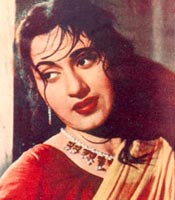 Madhubala is an epitome of beauty, who had an unbeatable charm. She is admired for her looks and work even by the present day generations. Madhubala's father named Ataullah Khan, on hearing the words of the Muslim holy man, planned to migrate to Bombay (now Mumbai) for leading a better life. Things were not smooth and the family had to struggle a lot for a year. Madhubala entered into the Indian film industry as a child artist. At that time, she was known as Baby Mumtaz.
Madhubala is an epitome of beauty, who had an unbeatable charm. She is admired for her looks and work even by the present day generations. Madhubala's father named Ataullah Khan, on hearing the words of the Muslim holy man, planned to migrate to Bombay (now Mumbai) for leading a better life. Things were not smooth and the family had to struggle a lot for a year. Madhubala entered into the Indian film industry as a child artist. At that time, she was known as Baby Mumtaz. Detainment by Police
Detainment by Police 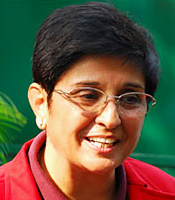 In the year 1993, the Department of Social Sciences, the Indian Institute of Technology in New Delhi awarded her with a Ph.D. degree. Her topic of research was Drug Abuse and Domestic Violence. Kiran Bedi has won the championship of all-India and all-Asian tennis competition. When she was 22 years old, she won the Asian Ladies Title.
In the year 1993, the Department of Social Sciences, the Indian Institute of Technology in New Delhi awarded her with a Ph.D. degree. Her topic of research was Drug Abuse and Domestic Violence. Kiran Bedi has won the championship of all-India and all-Asian tennis competition. When she was 22 years old, she won the Asian Ladies Title.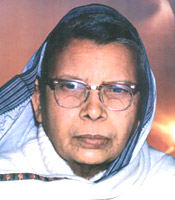 She was highly influenced by the values preached by the Buddhist culture. She was so much inclined towards Buddhism that, she even attempted to become a Buddhist bhikshuni. With the establishment of Allahabad (Prayag) Mahila Vidyapeeth, which was primarily set up to impart cultural values to girls, she became the first headmistress of the institute. This famous personality died in 1987.
She was highly influenced by the values preached by the Buddhist culture. She was so much inclined towards Buddhism that, she even attempted to become a Buddhist bhikshuni. With the establishment of Allahabad (Prayag) Mahila Vidyapeeth, which was primarily set up to impart cultural values to girls, she became the first headmistress of the institute. This famous personality died in 1987.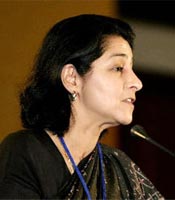 She began her career in the year 1982, when she joined the ANZ Grindlays Bank, which is now known as the Standard Chartered Bank. She took up a variety of banking assignments before moving to Morgan Stanley's India operation. She kept climbing the ladders of success. She played an important role in NYSE listing of Wipro. She was instrumental in facilitating the cellular phone services nationwide through a deal involving the Tatas and Birlas. Last November, she became the Managing Director of the HSBC bank.
She began her career in the year 1982, when she joined the ANZ Grindlays Bank, which is now known as the Standard Chartered Bank. She took up a variety of banking assignments before moving to Morgan Stanley's India operation. She kept climbing the ladders of success. She played an important role in NYSE listing of Wipro. She was instrumental in facilitating the cellular phone services nationwide through a deal involving the Tatas and Birlas. Last November, she became the Managing Director of the HSBC bank.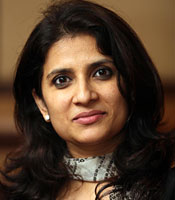 Prior to joining Kinetic Company, Sulajja worked for a period of four years with a well known investment analytics company, BARRA International, based in California. She has been an active participant in setting the operations of the company in India. Throughout her studies, she has been a rank holder. She has always cleared exams with merit. Her name appeared in the toppers list in the SSC examinations and HSC examinations. She graduated from the Pune University. Thereafter, she went to the United States for pursuing further studies. She is an MBA degree holder from the reputed Carnegie Mellon University at Pittsburgh.
Prior to joining Kinetic Company, Sulajja worked for a period of four years with a well known investment analytics company, BARRA International, based in California. She has been an active participant in setting the operations of the company in India. Throughout her studies, she has been a rank holder. She has always cleared exams with merit. Her name appeared in the toppers list in the SSC examinations and HSC examinations. She graduated from the Pune University. Thereafter, she went to the United States for pursuing further studies. She is an MBA degree holder from the reputed Carnegie Mellon University at Pittsburgh.




